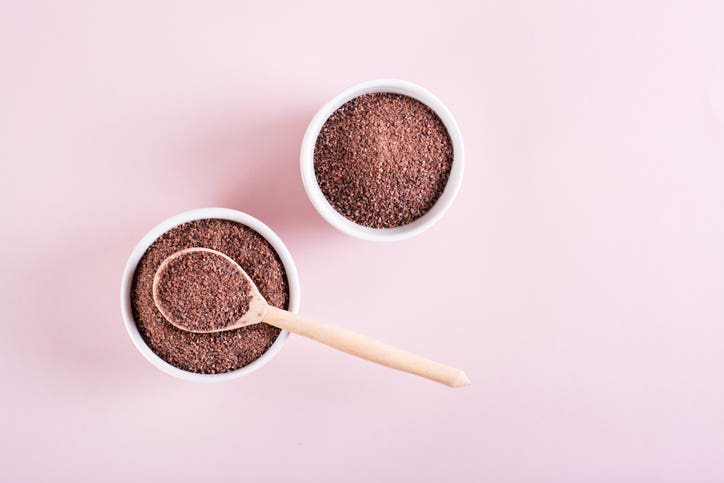
The 7 Best Yoga Poses to Relieve Gas and Bloating
By Megan Edwards,
Last Updated:Have you noticed an increase in flatulence after ditching animal products from your diet? You’re not the only one. Many people experience an uptick in bloating when they switch to a whole-food, plant-based diet because their plate consists of more high-fiber foods—which are great for your health, but not so great at reducing gas.
A 2017 study published in The American Journal of Gastroenterology assigned 412 participants to either a high-fiber diet or low-fiber diet over the course of several months, and found that people eating high-fiber diets were 41% more likely to experience bloating than those on the low-fiber diets.
The biochemistry behind your increased need to pass gas is pretty simple: As you digest, bacteria in your gut ferments food that isn’t fully digestible (i.e., fiber) and produces gas as a byproduct. The more fiber you eat, the more flatulence you might experience. The good news? Over time your digestive system will adjust to the diversity of your new diet and become more adept at processing high-fiber foods, reducing the frequency of post-meal gassiness.
How Much Farting is Normal?
While you may notice an uptick in flatulence when you go vegan, the average person already farts between 10-20 times a day. Sound like a lot of passed gas? You probably don't notice the frequency of your own flatulence because the vast majority of gas doesn't smell. Only compounds that contain sulfur, such as hydrogen sulfide, give your farts any sort of noticeable stink. Lots of veggies, legumes, and nuts contain small amounts of sulfur, but it likely won't change the odor of your gas very much because a healthy diet promotes a balanced gut microbiome. The main thing to remember is that flatulence is normal and is an essential part of a healthy digestive system—so keep the gas coming!
How Can I Naturally Relieve Gas?
Until your gut microbiome has adjusted to your new plant-based lifestyle, you can manage this uncomfortable—and sometimes loud—side effect of eating healthier with a few simple yoga poses. All of these postures move your body into shapes that help gas travel through the digestive system and decrease that tight, pressurized feeling in your belly. The next time you experience bloating after a meal try one of these yoga poses to relieve gas before you reach for the bottle of Tums.
Yoga Poses to Relieve Gas and Bloating
Ardha Apanasana (Knee to Chest)
Quite literally translated into English as “wind-relieving pose,” this posture is great for helping trapped gas move through your intestines.
- Lie flat on your back with legs extended out on the floor.
- Pull one knee into your chest, holding your leg around the shin or kneecap. The back of your head should stay planted on the floor.
- Keep the other leg extended out long. Hold this position for up to 5 minutes before switching sides.
- Alternatively, you can pull both knees into your chest so you are curled into a ball.
Ananda Balasana (Happy Baby)
While you might feel a little silly in this shape, Happy Baby is an excellent pose for releasing gas and relieving a bloated stomach.
- Lie flat on your back with knees bent and feet on the floor.
- Pull both knees up toward your chest and press feet toward the ceiling. Your knees will be bent.
- Grab onto your shins, ankles, or feet (depending on your flexibility). Gently pull knees closer toward the ground as your feet stay flexed up toward the ceiling and legs move gently apart.
- Keep head and neck pressed into the ground. If it feels good, you can rock from side to side. Hold this pose for 1 to 5 minutes.
Supta Matsyendrasana (Spinal Twist)
In this pose, think of your body like a washcloth that’s being wrung out to dry. Deep twists support the digestive system by compressing the organs to help move gas through the body.
- Lay flat on your back with legs extended out long on the floor.
- Pull your right knee into your chest by wrapping your hands around your shin or kneecap. Keep the left leg extended long.
- Draw your right knee across your body to the left. Your knee may touch the floor or it may hover; it just depends on what feels good in your body.
- Extend your right arm out to the side and turn your head to look over your right hand. Your left hand can stay on the bent knee or you can extend that arm out to the left side.
- Hold this pose for 1 to 5 minutes. Roll gently onto your back and repeat on the other side.
Anjaneyasana (Low Lunge)
A great hip-opening stretch that’s ideal for anyone who works at a computer all day, low lunges also help you pass gas by stretching out the pelvic muscles.
- Start in a kneeling position on your knees. Step your right foot forward while keeping the left knee on the ground.
- Place your hands on top of your right thigh or place them on the ground on either side of your front foot.
- To increase the intensity of the stretch in your hips, gently scooch the back left knee further behind you, widening the stance of your lunge.
- Hold this shape for 1 to 3 minutes. Bring the right knee back underneath your hips and step forward with the left leg to repeat on the other side.
Uttanasana (Forward Fold)
Forward folds use the power of gravity to create length in your spine and settle your stomach.
- Stand with your feet hip-distance apart.
- Hinge forward from your waist so that your torso is draped over your thighs. Allow your head and neck to dangle.
- Your legs can be straight, or you can bend your knees if you have a tight low back. Your hands can rest on the floor beside your feet, rest on top of your shins, or wrap behind your calves.
- Hold this shape for 1 to 3 minutes before slowly rolling back up to standing.
Malasana (Garland Pose)
A great way to make this flatulence-fighting shape more accessible is to tuck a yoga block or footstool underneath your hips so you can relax into the squat instead of muscling your way through it.
- Start standing with your feet wider than your hips and toes turned out on a diagonal angle.
- Squat down as far as you can so that your knees are deeply bent and your pelvis is resting between your legs.
- Bring your palms together in a prayer position in front of your heart and press your elbows into your knees to help keep your legs open wide.
Balasana (Child’s Pose)
A calming posture for both your gut and your mind, this classic yoga pose relieves tension in the pelvic area and low back.
- Start in a tabletop position on your hands and knees. Bring your big toes together to touch and send your knees out a little wider than your hips.
- Sink your hips back toward your heels, and crawl your arms out long. Your belly will rest between your thighs. Your forehead can rest on the ground or on a pillow.
- Hold this position for 2 to 5 minutes at a time. If you feel discomfort in your low back, try raising your hips so they are stacked over your knees while you keep your arms, head, and chest pressed down toward the floor.
Feel free to combine all these postures into a full gas-relieving sequence or simply try one pose at a time when the need arises.
This article was originally published on May 13, 2022, and has been updated.
To learn more about a whole-food, plant-based diet, visit our Plant-Based Primer. For meal-planning support, check out Forks Meal Planner, FOK’s easy weekly meal-planning tool to keep you on a healthy plant-based path.

About the Author

About the Author
Megan Edwards
Join our mailing list
Get free recipes and the latest info on living a happy, healthy plant-based lifestyle.
By providing your email address, you consent to receive newsletter emails from Forks Over Knives. We value your privacy and will keep your email address safe. You may unsubscribe from our emails at any time.